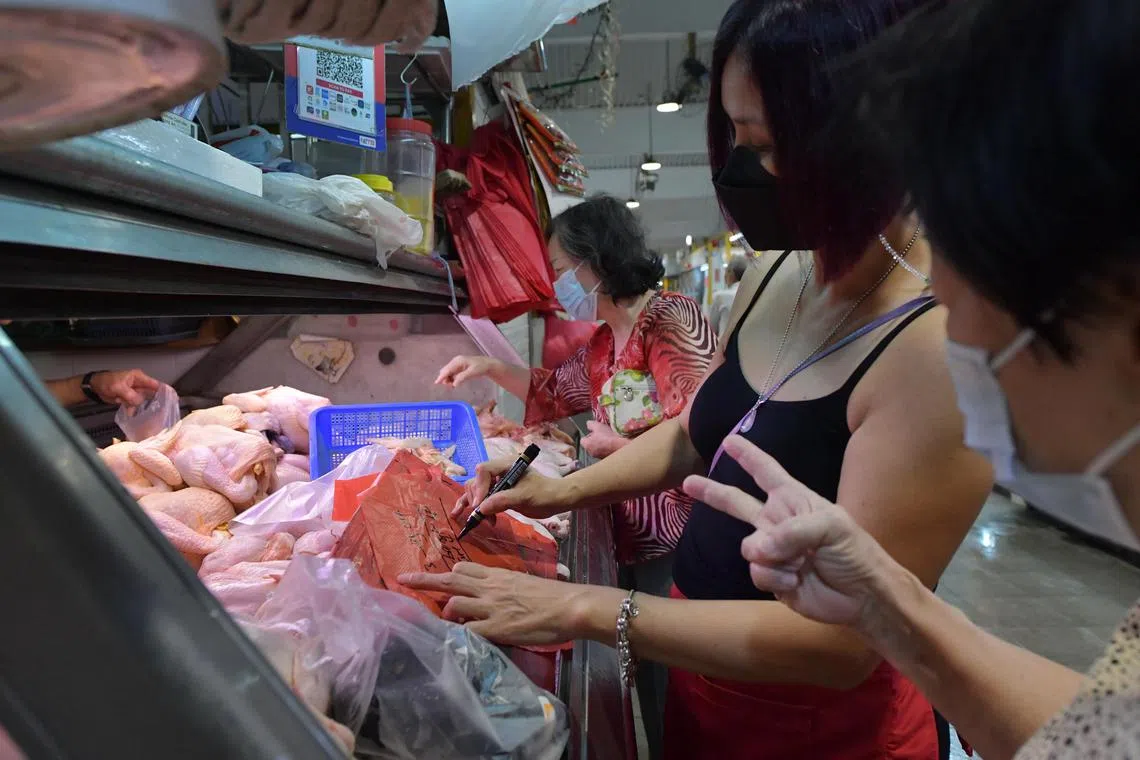Higher prices, fewer chickens 7 weeks after lifting of Malaysia export ban
Sign up now: Get ST's newsletters delivered to your inbox

Higher prices have kept some customers away while those who are still going are buying less than before.
ST PHOTO: ALPHONSUS CHERN
Follow topic:
SINGAPORE - Chicken sellers are seeing their earnings take a hit as higher prices and fewer birds eat into their profits, seven weeks after the ban on chicken imports from Malaysia was lifted.
Chicken sellers that The Straits Times spoke to at markets in Bukit Timah, Ghim Moh and Bedok said earnings have not returned to the level before the ban as the profit margin per bird is the same, but they do not have as many birds to sell as before.
Malaysia had said in October that Singapore would receive about 1.8 million Malaysian broiler chickens a month, half the number the Republic previously imported from across the Causeway before the June 1 ban.
Broiler chickens are larger birds that make up the bulk of what Singapore typically imports from Malaysia.
Minister for Sustainability and the Environment Grace Fu said in Parliament last Tuesday that the supply remains stable. She did not disclose the number of broiler chickens imported from Malaysia since the lifting of the ban.
Chicken sellers said they are not getting as many birds as before and that the higher prices have kept some customers away, while those who are still going to their stores are buying less than before.
Mr Peter Toh, 52, who runs Heng Huat Fresh Chicken at Ghim Moh Market, said: “I make about $1.20 for each kg of chicken I sell, so if I’m selling fewer birds, it means I can’t make as much.”
He said he used to pay $4.50 per kg for the chickens before the ban but is now paying around $6.80 per kg. He has had to adjust his prices from $6 per kg to $8 for the broiler chickens sold at his store.
He said: “Many of the people living around here are elderly. They can’t afford the prices now, and they don’t need to eat so much, so some of them don’t come as often, or they buy very little now. If I raise my price any further, then they might not come at all.”
Madam Chen, who is in her 40s and works at Ah Chuan Poultry Supplies at Bukit Timah Market, said: “Most people already got used to eating less chicken during the ban, and it’s more expensive now, so they buy a lot less.“
Declining to reveal her full name, she added: “It’s hard for us also because the supply of chicken from our distributors is not always stable, so we can’t be sure that we will have enough to sell to make ends meet.”
Mr Tan Chow Yong, 56, who runs a store at Bedok 85 Market, used to order several hundred broiler chickens every day from his suppliers prior to the ban, but now orders only about 70 birds.
“I’ve stopped ordering so much because there are fewer customers buying, and they buy so little. Even if I wanted to order more, I doubt I would be able to get all the birds I want,” he said.
Mr James Sim, head of business development at local chicken importer Kee Song Food, said that to date, the supply of chickens from Malaysia to his firm since the ban lifted has remained unchanged, at around 50 per cent of the previous capacity.
Customers ST spoke to similarly reflected sellers’ concerns.
Mrs Elsie Sim, 47, a housewife, said she used to buy a whole broiler chicken when she went to the market. The Toh Tuck resident said: “I come to the market at least three to four times each week. I used to buy one chicken, which had cost around $10 to $12, so that I can cook dinner for my husband and three children. Now, the same chicken is almost $20, so I’ll buy it only on weekends when I’m sure all of my family are eating at home; if not, it’s a waste.”
Others such as retiree Terence Seet, 61, said they are opting for frozen chicken parts as the fresh ones did not offer any substantial difference in flavour or texture despite costing more.
“I just buy some wings or breast meat to cook sesame chicken, so the freshness is not so important to me. I am living by myself, so I don’t cook too much anyway,” said the former mechanic, who lives in Ghim Moh.


